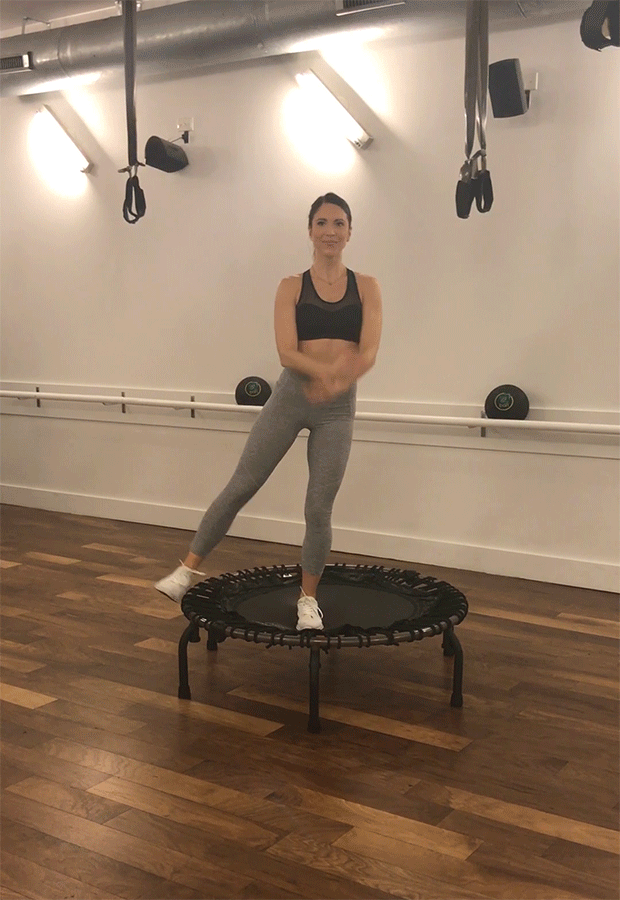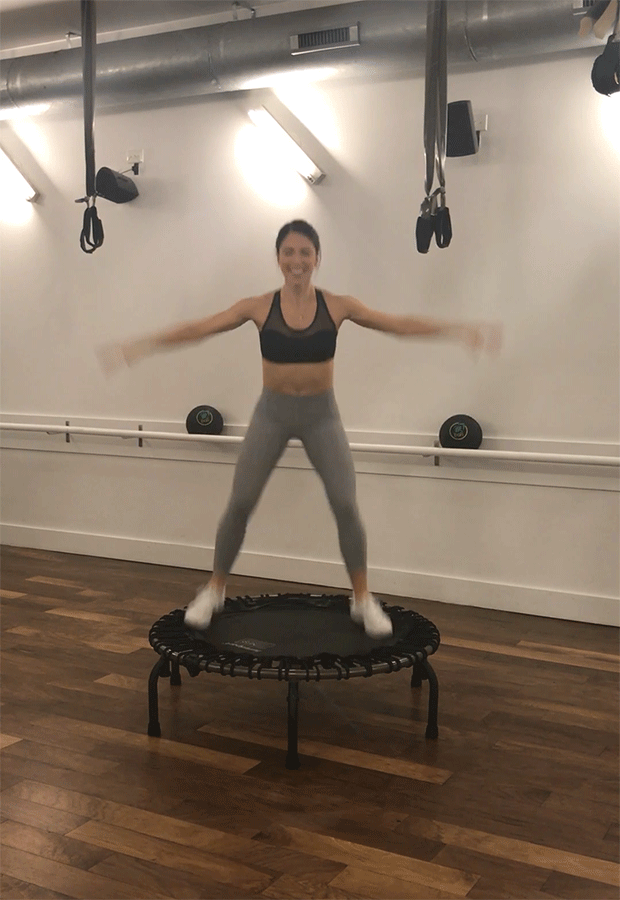Who would have thought that something we used to do as kids would take off as a fitness craze? Well, that’s exactly what has happened with trampolining. It's a super effective way to get fit whilst having fun, trampolining offers huge benefits compared to a more conventional work out, it can improve mental well-being, feelings of vitality and much more.
Here are just a few reasons why you should consider a trampoline fitness class...

Rebounding Improves Digestion & Gut Health
Jumping on a trampoline helps with digestion because the rhythmic up-down motion stimulates the contraction and relaxation of muscles that make up the digestive tract. Improved digestive peristalsis means the body is able to process and absorb nutrients more efficiently. This will help address nutritional deficiencies which are so prevalent among people with compromised digestive systems. When the body receives the nutrients it needs, it would have the necessary materials for self healing and rejuvenation. Moreover, activated peristaltic waves in the intestines allow food to pass through more quickly and wastes to be released, eliminating constipation.
Jumping Aids In Weight Loss
Jumping on the trampoline has been proven to increase your metabolic rate, and help to keep your weight down. Your metabolic rate remains elevated for up to 24 hours after you get off your trampoline. Rebounding is an extremely efficient calorie burner. Because of its many health benefits, it is a good exercise to incorporate into your weight loss plan. Improved lymphatic circulation which aids elimination of waste and toxins, also helps you to attain your weight loss goals quickly.
Try this bounce workout by Women's Health
Jumping Improves Mental Health
Frequent rebounding improves blood circulation. This allows an abundance of fresh oxygen to the brain, promoting mental sharpness and focus. Cross patterning activities on the trampoline, where movement performed on one side of the body is repeated on the other side, enhances communications between to the 2 hemispheres of the brain. This improves mental capacity and is known to help children with reading and writing.
Jumping on the trampoline also imparts a sense of well being. It triggers the release of endorphin, the “feel good” hormones to lift your moods, and to promote optimism and self confidence. Even bouncing for 1-2 minutes can relive stress & tension, even though it's not a full workout.

Bouncing Strengthens Eye Muscles
Jumping on the trampoline also helps strengthen your ocular nerves and eye muscles due to the effects of increased G-force on every part of the body. Eyes are semi-muscular organs that must be exercised like any other muscle in the body. Without exercise, the eye lenses can get out of shape just like the other parts of our body. Rebounding helps to stimulate the cells of the eye lenses to restore their original shape and function.

Bouncing Increases Bone Density
Regular rebounding helps to increase bone density and maintain bone mass for older adults. It is effective in preventing osteoporosis. Bones have the ability of becoming stronger under stress and weaker when there is no stress. The best way to do this is to work against gravity. Astronauts can lose up to 15% of their bone and muscle mass just 14 days in space at zero gravity. Rebounding is NASA’s main strategy to help rebuild bones and reverse osteoporosis in astronauts.
When you jump on a trampoline, the entire body shares the G-force impact. Unlike most exercises, rebounding strengthens the bones and muscles without the risks of injuries to weight bearing joints such as the knees, ankles, hips and back.
This is a must try class for a super sweat rebounder class
Jumping Strengthens Cells
Rebounding effectively causes all 37 trillion cells in the body to move up and down. The stress of gravity and G-force on each individual cell causes it to adjust to the increased load by becoming stronger, thereby increasing cell energy and mitochondrial function. Cellular health is so fundamental to our total health. When cells malfunction, they become susceptible to DNA damages. Mutated cells are precursors to chronic and degenerative diseases. When each cell is functioning optimally and harmoniously, constitutional strength and robust health is the inevitable result.
Jumping Helps Cardiorespiratory Fitness
Bouncing to a musical cadence of 135 beats per minute raised participants’ heart rate to an average maximum of 189 beats per minute, with oxygen consumption increasing to 64%–81% of maximum capacity. Even with movement restricted to the lower limbs, trampolining to songs including MC Hammer’s “U Can’t Touch This” (a 135 bpm song) for 10 minutes is enough to meet the recommendations.
Jumping Strengthens Your Core & Pelvic Floor
Back and stomach strengthening is one of the best benefits of doing trampoline work. Rebounding works out your whole core, as opposed to just your abdominal muscles, and keeping your core toned helps to protect your spine and lower back.
Basically, when you're jumping up and down, your spinal muscles contract to keep your back stable and straight, and this in turns helps to strengthen your back muscles. Remember, focusing on your whole core is an important component of any well-rounded fitness regimen (trampolining for the win)!
Rebounding is great for the pelvic floor muscles. Your pelvic floor is a group of muscles in the pelvic area that supports the internal organs there. Having a strong pelvic floor is important for bladder control, stabilizing the hip joints and improving your overall sexual health. Bouncing on the trampoline (even for just 15 to 20 minutes per day), can greatly help activate and tone the pelvic floor.

Bouncing Is Convenience
The trampoline or rebounder provides a set space in which you can exercise. You don’t need to get to the gym or tennis courts, you don’t need to find a route for your run or bike ride, you don’t even need to get changed into special clothes (apart from a good sports bra, for women.) The trampoline is in one place, easy to get to, offers privacy (unless your neighbours can see you bouncing over the fence!)
Get The Most Out Of Your Rebounding Workout:
Inhale when landing and exhale in the air — it’s what professional athletes do intuitively.
Rebounding mostly serves to strengthen leg muscles; after 10 minutes you’ll really feel the burn in your calves. For this reason, it’s important that you incorporate core and upper body moves in your workout, either as part of, or in addition to, rebounding.
A jump where you twist 360 degrees in the air (both clockwise and counterclockwise — one direction will be easier than the other) will strengthen your core stability, targeting your obliques in particular. As for your upper body, there’s no reason you can’t get creative with dumbbells while you bounce.
While trampolines absorb a lot of shock and distribute force fairly evenly through the body, extended bouncing may exacerbate neck or lower back pain in pre-existing conditions. (There are days when rebounding leaves me feeling a little “compressed” in the lower back.)
From slow and gentle to full-on aerobic workouts, YouTube is chockablock with exercise routines to inspire you, featuring treading, (single-leg) bouncing, jumping jacks/star jumps, tuck jumps, and twists.
There’s a mini-trampoline (“rebounder”) out there for all fitness levels and budgets, be sure to choose the right model for you. A tauter mat surface will provide the most tension, and ensure the most efficient workout. You might like to check out the slightly pricier, whisper-quiet bungee-cord kind, though traditional coil spring trampolines work too, you just may get a little tired of the constant squeaking! Shop our recommend mini-trampoline here.
Go get your bounce on!
The content provided in our articles is provided for information purposes only and is not a substitute for professional advice and consultation, including professional medical advice and consultation; it is provided with the understanding that YK DAILY is not engaged in the provision or rendering of medical advice or services. The opinions and content included in the articles are the views only and may not be scientifically factual. You understand and agree by reading anything on our website that YK DAILY shall not be liable for any claim, loss, or damage arising out of the use of, or reliance upon any content or information published. All images are from Pinterest, if you know the original creator please let us know, so that we can credit them.





